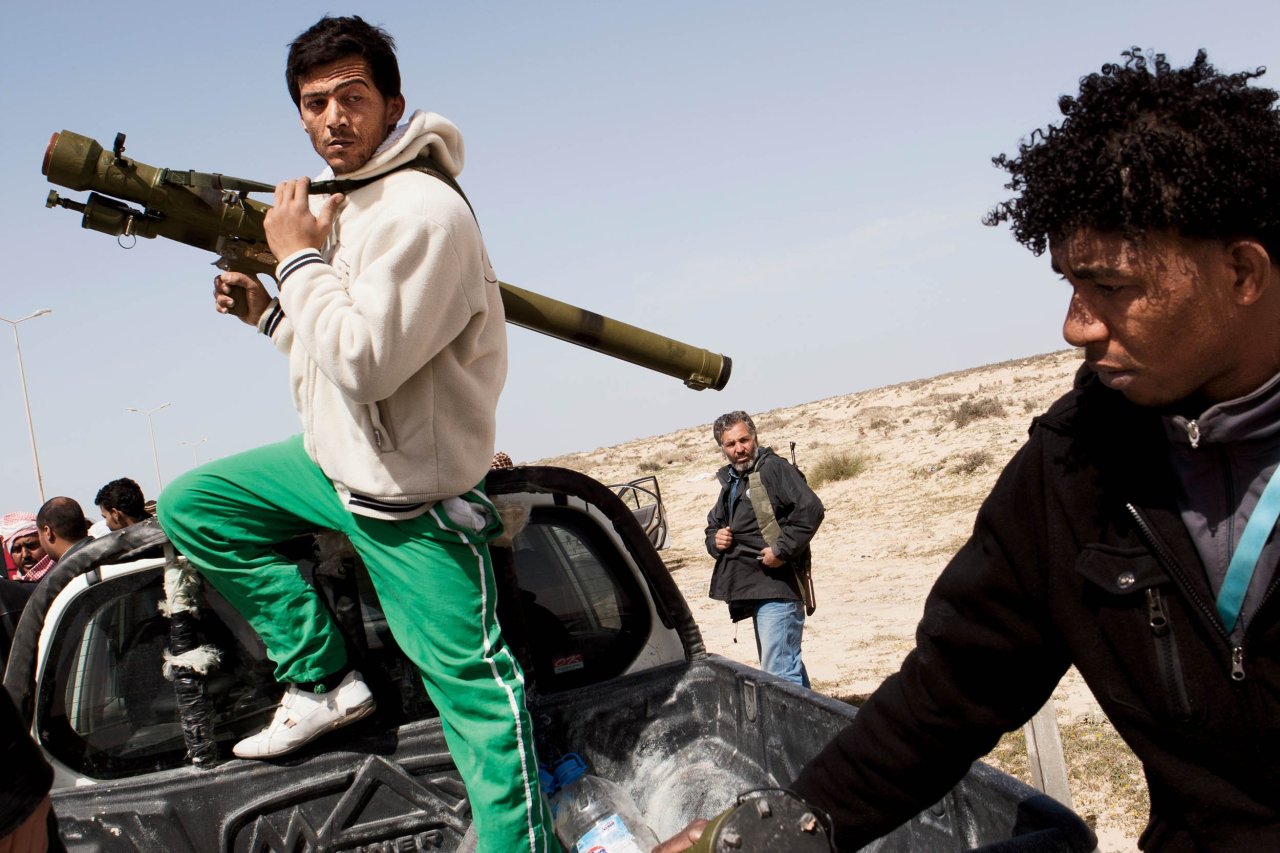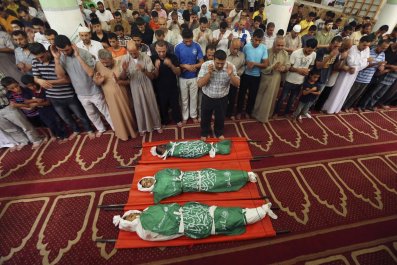Malaysia Airlines Flight MH17 was shot down at over 30,000 feet by a sophisticated missile system, but even a cheap shoulder-fired weapon of the kind that has proliferated since the wars in Libya and Syria could easily bring down a plane, especially in the vulnerable minutes around takeoff and landing.
Airlines and governments have rushed to offer assurances about how a similar disaster will never happen again, but some security and aviation experts aren't so sure.
"Events like MH17 and the impact it has had—with a global audience—will only serve to inspire terrorist groups such as ISIS and Al-Qaeda," says Mark Birdsall, editor of the international security magazine Eye Spy. "It is a graphic reminder that downing a passenger plane would devastate the morale of their perceived enemy, massively denting confidence."
He adds that insurgent groups, like ordinary criminals, "have a tendency to imitate counterparts, carrying out copycat attacks perhaps because they are inspired by an example or else because they don't want to lose the limelight."
Even lightly armed militias, with little formal training, are capable of perpetrating such attacks. All aircraft are vulnerable when they take off and land, points out Chris Yates, a leading authority and consultant on aviation safety. "This is when airliners are at significant risk and vulnerable to small-arms fire that is quite capable of downing any airliner."
This kind of small arms—such as portable missiles fired from the shoulder—are becoming not just more lethal but more widely available. Justin Bronk, a researcher at the Royal United Services Institute (RUSI) in London, points out that two heat-seeking missiles, the SA-18 and its "even more lethal replacement" the SA-24, are "amongst the most effective man-portable anti-aircraft systems today."
Carrying a 2.6-pound warhead over a range of more than three miles, the SA-24 heat-seeking missile is a deadly weapon even against warplanes. It brought down NATO aircraft in war zones such as Bosnia and Iraq. Fired from the shoulder, these weapons are easy to transport and relatively cheap, costing just a few thousand dollars on the international arms market. They are also easy to operate, with a simple trigger and a straightforward optical-guidance system. Just one of these missiles can bring down a 747 (which can carry as many as 467 passengers), and each poses "a significant threat to any aircraft below 20,000 feet," says Bronk.
This relatively close range option presents an attacker with considerable opportunities.
"Airliners start to reach the 20,000-foot threshold a considerable distance—around 25 miles—from the airport where they touch down," says Robert Mark, a commercial pilot and publisher of Jetwhine.com.
An airliner might take as much as 12 minutes to fly this 25-mile distance as it takes off and lands, although this time can vary considerably. So any passenger jet, even one making the shortest of trips, might be exposed to such dangers for around 25 minutes of its travel time, perhaps more.
Aircraft are more vulnerable in developing countries that lack the effective infrastructure to keep tight control over such large areas. It was significant that insurgents chose to attack, and narrowly missed, an El Al plane as it took off from Mombasa, Kenya, in November 2002, firing just one mile from the runway. However, it would be even easier for attackers to take cover, directly under a flight path, in the big cities of the developing world. Aircraft most at risk are those with flight paths leading directly over vast urban areas, such as New Delhi, India; Lahore, Pakistan; and Johannesburg.
Deadly portable weapons have proliferated. Perhaps hundreds of them are reported to have disappeared from Libya during the civil conflict in 2011, and Syria has been the game-changer.
"The drawn-out conflict in Syria has certainly increased small-arms proliferation in the region," says Bronk. "Non-state actors like ISIS and Al-Nusra have captured large stockpiles of small arms from government forces in both Syria and Iraq. What's more, Chinese versions of these missile systems are also reportedly being covertly supplied to opposition forces in Syria."
Many insurgent groups possess more sophisticated SA-7 heat-seeking missiles, which are specifically designed to bring down aircraft. These missiles, which have a range of about 12,000 feet, are easy to carry around and require just a few hours of training to operate effectively. The U.S. Federal Aviation Administration currently advises airlines against flying over Congo beneath a certain altitude precisely because of the danger these missiles pose: In October 1998, rebels brought down a B-727 with a single, simple SA-7 missile.
Very few airlines appear to have taken precautions against such dangers. "Other than a handful of Middle Eastern and Russian private jets, only Israel's national airline, El Al, is known to have taken technical countermeasures to fend off the threat posed by heat-seeking missiles," says Norman Shanks, an expert on aviation safety.
After the Mombasa attack, El Al became the world's first airline to fit an anti-missile protection system, but others have not followed its example. A slow-moving airliner is potentially a sitting duck against a missile like the SA-24.
Much more sophisticated equipment is needed to strike an aircraft once it reaches 32,000 feet. The missile that is thought to have struck Flight MH17—fired from an SA-11 "Buk" or "Gadfly" system—has a range of more than double that height, matching the power of its NATO counterparts.
Brock argues that insurgents could learn how to operate an SA-11 if they acquired one. "It may be possible for individuals with limited experience of the system, or with a few days' instruction by technical specialists, to perform some basic functions of achieving radar lock on a large contact and then firing on it. So it is not beyond the means of Syrian rebels with international backers and recruits to operate such a system to a sufficient level as to be a danger to airliners."
Nor is it inconceivable that insurgent groups or irregular armies could obtain such highly sophisticated and valuable equipment. "Weaponry is becoming increasingly available, and the fact that the Ukrainian separatists obtained the SA-11 shows how it can get into the wrong hands," warns Raffaello Pantucci, a RUSI expert.
Virtually every government is bound by the Convention on International Civil Aviation (or Chicago Convention), which obliges them to respect the safety of civilian flights. But insurgents have no obligation to the treaty. They can deny their involvement and then simply vanish.
Airlines cannot even count on the level-headedness of the regular armies that possess weapons as formidable as the SA-11. The crew that operates such systems might be poorly trained or inexperienced and therefore capable of making operational errors.
The SA-11 has radar that is capable of detecting civilian flights, which emit a distinctive transponder signal. But, adds Brock, "the operators may still be insufficiently proficient with the system to realize what those readings mean."
Such tragedies can happen, even to the best-trained armed forces. In July 1988, the U.S. Navy shot down an Iranian airliner, Flight 655, claiming it mistook the Airbus 300 for a hostile warplane; 290 people on board were killed. A repeat of what occurred high above Ukraine can never be ruled out.






























